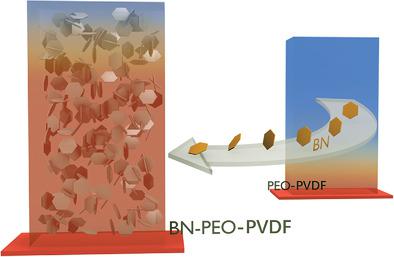Our official English website, www.x-mol.net, welcomes your feedback! (Note: you will need to create a separate account there.)
Thermal Conductive 2D Boron Nitride for High‐Performance All‐Solid‐State Lithium–Sulfur Batteries
Advanced Science ( IF 15.1 ) Pub Date : 2020-08-20 , DOI: 10.1002/advs.202001303 Xuesong Yin 1 , Liu Wang 2 , Yeongae Kim 3 , Ning Ding 1 , Junhua Kong 1 , Dorsasadat Safanama 4 , Yun Zheng 1 , Jianwei Xu 1 , Durga Venkata Maheswar Repaka 1 , Kedar Hippalgaonkar 1 , Seok Woo Lee 3 , Stefan Adams 4 , Guangyuan Wesley Zheng 1, 2
Advanced Science ( IF 15.1 ) Pub Date : 2020-08-20 , DOI: 10.1002/advs.202001303 Xuesong Yin 1 , Liu Wang 2 , Yeongae Kim 3 , Ning Ding 1 , Junhua Kong 1 , Dorsasadat Safanama 4 , Yun Zheng 1 , Jianwei Xu 1 , Durga Venkata Maheswar Repaka 1 , Kedar Hippalgaonkar 1 , Seok Woo Lee 3 , Stefan Adams 4 , Guangyuan Wesley Zheng 1, 2
Affiliation

|
Polymer‐based solid‐state electrolytes are shown to be highly promising for realizing low‐cost, high‐capacity, and safe Li batteries. One major challenge for polymer solid‐state batteries is the relatively high operating temperature (60–80 °C), which means operating such batteries will require significant ramp up time due to heating. On the other hand, as polymer electrolytes are poor thermal conductors, thermal variation across the polymer electrolyte can lead to nonuniformity in ionic conductivity. This can be highly detrimental to lithium deposition and may result in dendrite formation. Here, a polyethylene oxide‐based electrolyte with improved thermal responses is developed by incorporating 2D boron nitride (BN) nanoflakes. The results show that the BN additive also enhances ionic and mechanical properties of the electrolyte. More uniform Li stripping/deposition and reversible cathode reactions are achieved, which in turn enable all‐solid‐state lithium–sulfur cells with superior performances.
中文翻译:

用于高性能全固态锂硫电池的导热二维氮化硼
基于聚合物的固态电解质被证明在实现低成本、高容量和安全的锂电池方面非常有前景。聚合物固态电池面临的一项主要挑战是相对较高的工作温度(60-80°C),这意味着操作此类电池将因加热而需要大量的升温时间。另一方面,由于聚合物电解质是不良热导体,整个聚合物电解质的热变化会导致离子电导率的不均匀性。这对锂沉积非常不利,并可能导致枝晶形成。这里,通过掺入二维氮化硼(BN)纳米片开发了一种具有改善热响应的聚环氧乙烷基电解质。结果表明,BN 添加剂还增强了电解质的离子和机械性能。实现了更均匀的锂剥离/沉积和可逆阴极反应,从而使全固态锂硫电池具有优异的性能。
更新日期:2020-10-07
中文翻译:

用于高性能全固态锂硫电池的导热二维氮化硼
基于聚合物的固态电解质被证明在实现低成本、高容量和安全的锂电池方面非常有前景。聚合物固态电池面临的一项主要挑战是相对较高的工作温度(60-80°C),这意味着操作此类电池将因加热而需要大量的升温时间。另一方面,由于聚合物电解质是不良热导体,整个聚合物电解质的热变化会导致离子电导率的不均匀性。这对锂沉积非常不利,并可能导致枝晶形成。这里,通过掺入二维氮化硼(BN)纳米片开发了一种具有改善热响应的聚环氧乙烷基电解质。结果表明,BN 添加剂还增强了电解质的离子和机械性能。实现了更均匀的锂剥离/沉积和可逆阴极反应,从而使全固态锂硫电池具有优异的性能。



























 京公网安备 11010802027423号
京公网安备 11010802027423号